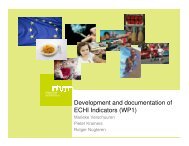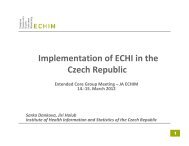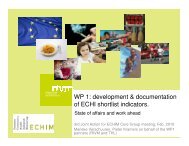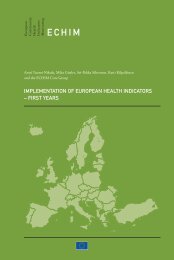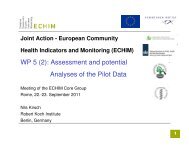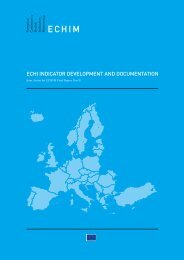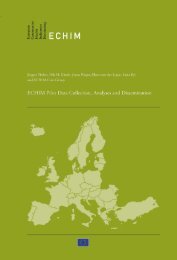INDICATORS
ECHIM Final Report
ECHIM Final Report
You also want an ePaper? Increase the reach of your titles
YUMPU automatically turns print PDFs into web optimized ePapers that Google loves.
User windows can also be found in the ECHI-2 report and the allocation of an indicator<br />
to one or more user windows is shown in the first column (as UW-x). As explained<br />
in the main text of that report, user windows are formulated as subsets of indicators,<br />
selected from a specific perspective.<br />
The new ECHIM comprehensive list<br />
As a part of the development of the ECHI shortlist, all Public Health Programme<br />
project leaders whose projects had been accepted from 2003 to 2006 (after ECHI-2<br />
project) were asked in January 2008 if their project has developed health indicators.<br />
The ECHIM Products website provides a link to this list. The received information<br />
has been organised chronologically according to the respective strands and reference<br />
numbers in three Excel sheets. The overview gives information of 28 projects within<br />
the strand “health information”, 7 projects within the strand “health threats” and 12<br />
projects within the strand “health determinants”. For each project, the sheets contain<br />
the following information:<br />
• Project title and year<br />
• Short description of the project<br />
• Organisation, project leader and his/her e-mail address<br />
• Link to the project website<br />
• Publication report (if available)<br />
• Project reference number<br />
Content block 3: Link to ICHI-2<br />
The aforementioned ICHI-2 website is linked to the ECHIM Products website. This<br />
was done for the following reasons. Earlier the ICHI-2 website was the only website<br />
containing a very broad collection of health indicators from Eurostat, OECD and<br />
WHO, together with the ECHI longlist indicators. The website is still used by a couple<br />
of hundred users a month and gives a comparative overview of the definitions of health<br />
indicators used by those organisations, until approximately July 2005. For several<br />
reasons it was decided to stop updating this website. First, as time went by the websites<br />
of the organisations involved have evolved into user-friendly websites that make their<br />
indicator information easy to access. Second, the organisations differ in their way of<br />
data presentation either as indicators (WHO), variables (OECD) or as “raw” aggregated<br />
data (Eurostat), and also in different hierarchies. All of this makes updating the database<br />
a tricky and difficult task. On the start page of the ICHI-2 website, there is a clear-cut<br />
explanation of its status. As the follow-up of the ICHI-2 compendium, the content<br />
block “Indicators on the web” (see below) will provide links to the websites of Eurostat,<br />
OECD and WHO where all background information and metadata can be found.<br />
206



